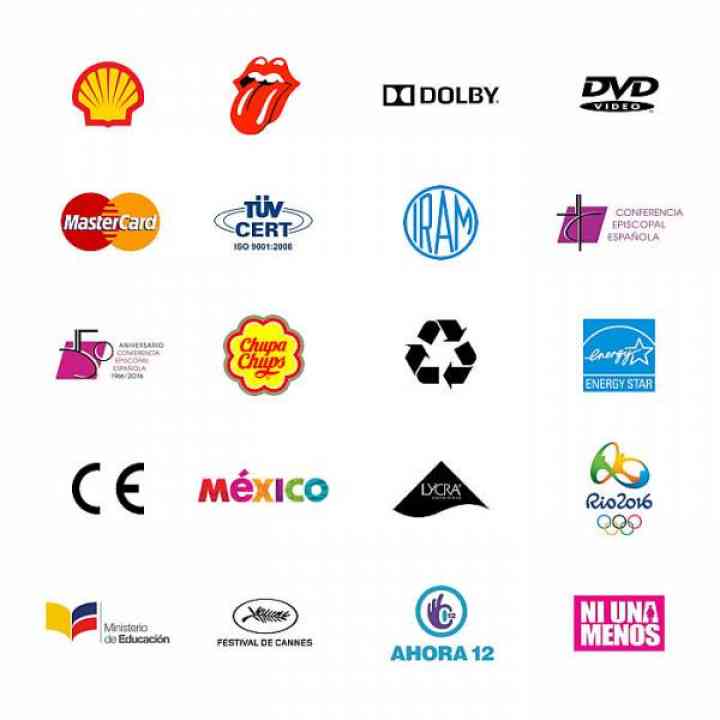The Functions of a Logo: How to Design Effective Visual Identities
Not all logos serve the same purpose. Understanding their functions is key to designing effective visual identities aligned with their goals.

Editor's Selection
What are the logos of Shell, Rolling Stones (the rock band), Dolby, DVD Video, MasterCard, BSI Certification, Church of England, 50th Anniversary of the Church of England, Chupa Chups, Recyclable Product, Energy Star, UKCA Mark, United Kingdom, Lycra, Commonwealth Games Birmingham 2022, Department for Education UK, etc., really used for?
What are the logos of Shell, Rolling Stones (the rock band), Dolby, DVD Video, MasterCard, BSI Certification, Spanish Episcopal Conference, 50th Anniversary of the Spanish Episcopal Conference, Chupa Chups, Recyclable Product, Energy Star, UKCA Mark, Mexico, Lycra, Commonwealth Games Birmingham 2022, Department for Education UK, etc., really used for?
Clearly, all these brand marks are used to visually refer to the mentioned entities, which are highly diverse in nature: companies, institutions, places, public agencies, products, certifications, communication campaigns, events, commemorations, artists, etc. However, by analyzing each case individually, we can break down this concept of “visually referring” into much more specific functions.
For example, the Dolby System logo applied to an audio device does not serve the same function as the Sony logo on the same device: the former indicates an attribute or characteristic of the device, while the latter denotes its manufacturer. Similarly, the Lycra logo serves different purposes when applied to the packaging of Lycra material versus when used on the label of a product from another brand made with Lycra: in the first case, it indicates the packaging’s contents (Lycra), and in the second, it describes a characteristic of another product (made with Lycra).
What Functions Can Logos Serve? What Are They Really Used For?
Clearly, logos are used to identify, but the identificatory function is not always exactly the same; it can be broken down. By analyzing the common uses of all types of brand marks, we can identify eight distinct functions:
-
Identify by Name
This soap is Lux, and this other is Dove (on the packaging and product)
This beer is Corona (on the label)
These pants are Levi’s (on the back pocket and label) -
Indicate Ownership
This blanket is from American Airways (on an in-flight blanket)
This vehicle is from UPS -
Indicate Physical Location
This is AT&T’s headquarters (on the roof of the tower)
This is a Gap store (at the entrance) -
Indicate Social Presence
HSBC operates in this city (on a billboard on a major highway)
Hilton has arrived in this country (on an airport sign) -
Sign
This is an advertisement from Samsung (at the bottom of a press ad)
This document is from Verizon (on the monthly mobile service bill) -
Endorse or Support
This product is from Unilever (on the back of Dove soap packaging)
This wine is from Concha y Toro wineries (on the “Casillero del Diablo” label) -
Sponsor
McDonald’s maintains this plaza
This event is funded by Coca-Cola -
Attribute Characteristics
Sometimes, the brand mark serves to qualify or express a characteristic, either of itself or another entity. For example:-
Indicate Milestone
This company has reached 50 years -
Guarantee
Curry’s, “guarantee of trust”
Carrefour, “the lowest price or we refund the difference” -
Indicate Origin
This wine is a Napa Valley
These cigars are made in Cuba -
Declare Ingredients/Materials
This product contains NutraSweet
This dessert contains Oreo cookies
This computer has an Intel processor (“Intel Inside”)
This product is made with recycled materials -
Certify
This company complies with BSI standards
This product meets UL standards -
Indicate Compatibility
This app is available for Android
This program is designed for Windows 10 -
Indicate Award
This film won an award at the Sundance Film Festival
Opel Astra was named “Car of the Year” in Europe 2016 -
Etc.
As can be observed, for a relationship to exist in which one entity qualifies or expresses a characteristic of another, the brand marks of both entities must coexist in the same statement or visual context: one will be the mark of the characterized entity, and the other will serve as the characterizing mark.
-
What Types of Entities Use Logos and for What Purposes?
Let’s now analyze which of these functions are typically useful for different types of entities. And what types of entities are possible? To simplify the analysis, I propose five groupings that, in principle, cover all possible cases: organizations, places, productions, campaigns, and entity attributes.
Below, we list examples of each type of entity included in each group and indicate which of the eight functions might apply to each:
-
Organizations: companies, institutions, public agencies, political groups, governments, government administrations, etc.
Functions: all
-
Places: cities, countries, regions, tourism brands, origin brands, etc.
Functions: all
-
Productions: tangible products, services, events, government programs, corporate or institutional programs, etc.
Functions: identify by name, sign, sponsor, and attribute characteristics.
-
Campaigns (communication): advertising, promotional, public interest, advocacy, or any type of cause or slogan campaigns, etc.
Functions: identify by name, sign, and attribute characteristics.
-
Attributes: guarantee seals, compatibility indicators, standards compliance indicators, commemorative marks, awards, ingredient marks, characteristic marks, material marks, etc.
Functions: identify by name and attribute characteristics.
| Function | Organizations | Places | Productions | Campaigns | Attributes |
|---|---|---|---|---|---|
| 1. Identify by Name | ● | ● | ● | ● | ● |
| 2. Indicate Ownership | ● | ● | |||
| 3. Indicate Physical Location | ● | ● | |||
| 4. Indicate Social Presence | ● | ● | |||
| 5. Sign | ● | ● | ● | ● | |
| 6. Endorse or Support | ● | ● | |||
| 7. Sponsor | ● | ● | ● | ||
| 8. Attribute Characteristics | ● | ● | ● | ● | ● |
We have thus arrived at a sort of “map of possible functions” for the brand mark of each type of entity. Of course, the analysis of required functions must be conducted for each specific case. That’s why we noted that these are functions that “might” apply, as it depends on the case: not all organizations need their mark to indicate ownership, as not all have properties; not all products need to endorse other brands; not all communication campaigns need to indicate presence, as most operate in communicative rather than physical spaces; not all places need to sign their own messages, etc.
Why Is It Useful to Understand the Functions of Brand Marks?
What is the purpose of the analysis of brand mark functions we have conducted? Undoubtedly, it aids in better design, providing clearer technical guidelines before developing graphic strategies for designing new marks or auditing existing logos. In short, knowing that a brand mark must fulfill certain functions and not others is critical for defining some of its technical requirements. Designing a mark that serves both to sign commercial messages and indicate ownership requires different graphic considerations than a mark that only needs to endorse other entities. Recognizing these functions can be decisive (though not sufficient) for establishing concrete graphic guidelines for the mark, such as limiting its color palette, determining the appropriate mark type and graphic style, and defining its characteristics in relation to other technical performance parameters (versatility, relevance, reproducibility, legibility, attention-grabbing, uniqueness, etc.) developed by Norberto Chaves and Raúl Belluccia.
This article was originally written in Spanish and adapted for English using AI to facilitate global dissemination.
Professional Excellence
If you are looking for content with this level of rigor, you will be interested in our academic offer. Courses designed to meet the real demands of the profession.
View Academic OfferShare
Please value the editorial work by using these links instead of reproducing this content on another site.

Topics covered in this article
What do you think?
Your perspective is valuable. Share your opinion with the community in the discussion.
Comment now!


